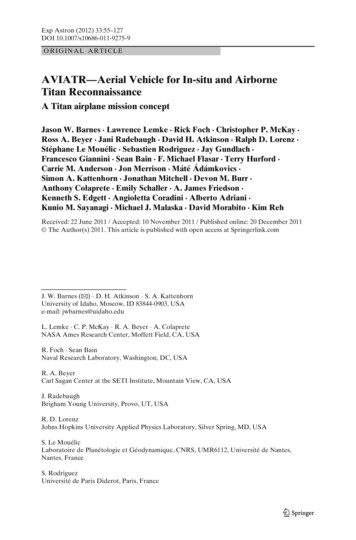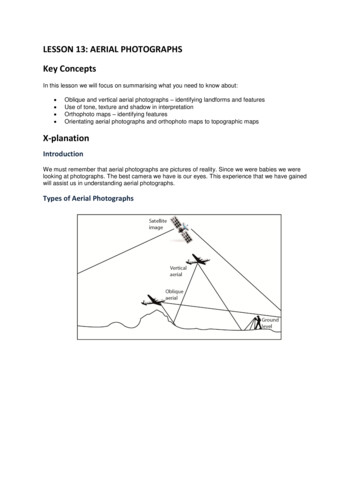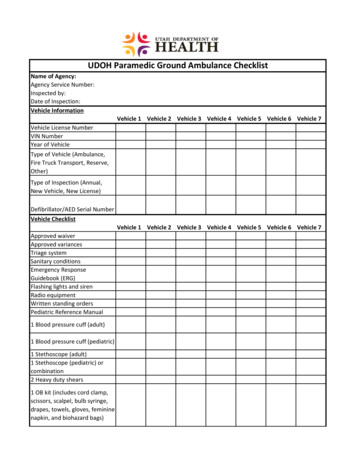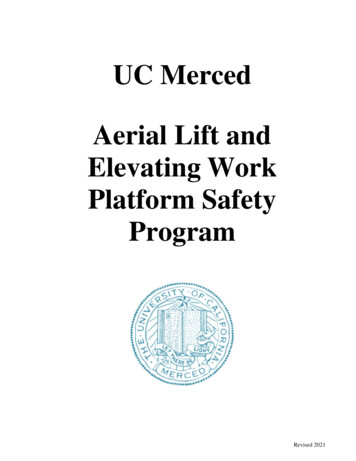
Transcription
Exp Astron (2012) 33:55–127DOI 10.1007/s10686-011-9275-9ORIGINAL ARTICLEAVIATR—Aerial Vehicle for In-situ and AirborneTitan ReconnaissanceA Titan airplane mission conceptJason W. Barnes · Lawrence Lemke · Rick Foch · Christopher P. McKay ·Ross A. Beyer · Jani Radebaugh · David H. Atkinson · Ralph D. Lorenz ·Stéphane Le Mouélic · Sebastien Rodriguez · Jay Gundlach ·Francesco Giannini · Sean Bain · F. Michael Flasar · Terry Hurford ·Carrie M. Anderson · Jon Merrison · Máté Ádámkovics ·Simon A. Kattenhorn · Jonathan Mitchell · Devon M. Burr ·Anthony Colaprete · Emily Schaller · A. James Friedson ·Kenneth S. Edgett · Angioletta Coradini · Alberto Adriani ·Kunio M. Sayanagi · Michael J. Malaska · David Morabito · Kim RehReceived: 22 June 2011 / Accepted: 10 November 2011 / Published online: 20 December 2011 The Author(s) 2011. This article is published with open access at Springerlink.comJ. W. Barnes (B) · D. H. Atkinson · S. A. KattenhornUniversity of Idaho, Moscow, ID 83844-0903, USAe-mail: jwbarnes@uidaho.eduL. Lemke · C. P. McKay · R. A. Beyer · A. ColapreteNASA Ames Research Center, Moffett Field, CA, USAR. Foch · Sean BainNaval Research Laboratory, Washington, DC, USAR. A. BeyerCarl Sagan Center at the SETI Institute, Mountain View, CA, USAJ. RadebaughBrigham Young University, Provo, UT, USAR. D. LorenzJohns Hopkins University Applied Physics Laboratory, Silver Spring, MD, USAS. Le MouélicLaboratoire de Planétologie et Géodynamique, CNRS, UMR6112, Université de Nantes,Nantes, FranceS. RodriguezUniversité de Paris Diderot, Paris, France
56Exp Astron (2012) 33:55–127Abstract We describe a mission concept for a stand-alone Titan airplanemission: Aerial Vehicle for In-situ and Airborne Titan Reconnaissance (AVIATR). With independent delivery and direct-to-Earth communications, AVIATR could contribute to Titan science either alone or as part of a sustainedTitan Exploration Program. As a focused mission, AVIATR as we haveenvisioned it would concentrate on the science that an airplane can do best:exploration of Titan’s global diversity. We focus on surface geology/hydrologyand lower-atmospheric structure and dynamics. With a carefully chosen set ofseven instruments—2 near-IR cameras, 1 near-IR spectrometer, a RADARaltimeter, an atmospheric structure suite, a haze sensor, and a raindropdetector—AVIATR could accomplish a significant subset of the scientificobjectives of the aerial element of flagship studies. The AVIATR spacecraftstack is composed of a Space Vehicle (SV) for cruise, an Entry Vehicle (EV)for entry and descent, and the Air Vehicle (AV) to fly in Titan’s atmosphere.Using an Earth-Jupiter gravity assist trajectory delivers the spacecraft to Titanin 7.5 years, after which the AVIATR AV would operate for a 1-Earthyear nominal mission. We propose a novel ‘gravity battery’ climb-then-glidestrategy to store energy for optimal use during telecommunications sessions.We would optimize our science by using the flexibility of the airplane platform,generating context data and stereo pairs by flying and banking the AV insteadJ. Gundlach · F. GianniniAurora Flight Sciences, Manassas, VA, USAF. Michael FlasarNASA Goddard Space Flight Center, Greenbelt, MD 20771, USAT. Hurford · C. M. AndersonNASA/GSFC, Greenbelt, MD 20771, USAJ. MerrisonUniversitat Aarhus Aarhus, DenmarkM. ÁdámkovicsUniversity of California, Berkeley, Berkeley, CA, USAJ. Mitchell · K. M. SayanagiUniversity of California, Los Angeles, Los Angeles, CA, USAD. M. BurrUniversity of Tennessee, Knoxville Knoxville, TN, USAE. SchallerUniversity of Arizona, Lunar and Planetary Laboratory, Tucson, AZ, USAA. J. Friedson · D. Morabito · K. RehJet Propulsion Laboratory, California Institute of Technology, Pasadena, CA, USAK. S. EdgettMalin Space Science Systems, San Diego, CA, USA
Exp Astron (2012) 33:55–12757of using gimbaled cameras. AVIATR would climb up to 14 km altitude anddescend down to 3.5 km altitude once per Earth day, allowing for repeatedatmospheric structure and wind measurements all over the globe. An initialTeam-X run at JPL priced the AVIATR mission at FY10 715M based on therules stipulated in the recent Discovery announcement of opportunity. Hencewe find that a standalone Titan airplane mission can achieve important sciencebuilding on Cassini’s discoveries and can likely do so within a New Frontiersbudget.Keywords Titan · Mission concept · Airplane · UAV1 Introduction1.1 HistoryTitan was first explored by spacecraft by the Pioneer 11 during its Saturnflyby on 1979 September 1 [40]. NASA’s Voyager 1 spacecraft prioritized aTitan encounter on 1980 November 12 rather than having Saturn send it on toUranus and Neptune, like Voyager 2. Voyager 1’s camera revealed that Titan’satmosphere is laden with organic haze particles, somewhat akin to smog onEarth [133]. Unfortunately incoming and outgoing light scatter off of thosehaze particles, preventing a clear view of the surface in visible light from space.Voyager 1 did document the distribution of haze and noted detached hazelayers in Titan’s upper atmosphere [133]. Given the Voyager data, scientistsrecognized that Titan is an organic chemist’s paradise, but knew essentiallynothing about the moon’s surface.The Cassini spacecraft’s Titan investigation was designed primarily to followup on the Voyager 1 chemistry discoveries. Several of its instruments, however,could be used to study the surface. The Huygens probe’s DISR descendedbelow the haze to image the surface close-up, but saw only a tiny region ofwhat turns out to be a very diverse surface. Huygens was, however, limitedin the amount of data returned ( 100 Mbit). Cassini was also equipped witha RADAR to perform reconnaissance of Titan’s landscape hidden beneaththe haze. After selection (but before launch), Griffith et al. [43] realized thatCassini’s VIMS and ISS would also be able to see the surface. This predictionwas confirmed by spatially-resolved near-infrared observations of Titan’ssurface from both HST [134] and ground-based adaptive optics [31]. CassiniA. Coradini · A. AdrianiINAF, IFSI, Rome, ItalyM. J. MalaskaSCYNEXIS, Inc., Research Triangle Park, NC, USA
58Exp Astron (2012) 33:55–127has been a phenominal success (see [24] for a review of Cassini discoveriesat Titan to date). In addition to fundamental breakthroughs regarding Titan’sorganic chemistry, Cassini’s RADAR and near-infrared observations, alongwith those from the Huygens probe, have taught us what questions to askregarding Titan’s surface and lower atmosphere.Coustenis et al. [34] recently reviewed the prospects for in situ probesthroughout the solar system. In an early survey of post-Cassini Titan exploration possibilities, Lorenz [72] noted the ability for in situ elements to enterTitan’s atmosphere directly from an interplanetary trajectory, and exploresthe relative utility of various aerial platforms. This and other concepts fromthe early 2000s like the Titan Vision studies [68, 87], Titan Aerorover OrbiterMission [132], and Titan Planetary Explorer [119] focused on aerial vehicleswith surface access capability.Because use of a single vehicle for both aerial and surface science greatlyincreases complexity, cost, and risk, the 2007 Titan Explorer flagship study[79] separated the in situ science into an aerial vehicle and separate lander(s).The Titan Explorer flagship study [79], the European TandEM study [32], andthe more recent TSSM study [120] included 3 elements: an orbiter, an aerialelement (hot-air balloon), and a lander (see [76] for a review of Titan missionstudies). In this scenario each mission element would independently addressoverlapping sets of science objectives.In general, the use of an airplane for Titan in situ studies has been considered but dismissed without thorough investigation [36]. While the flagshipstudies ultimately favored balloons over airplanes as their atmospheric element, Titan airplanes had been considered several times before that. Zubrin[169], for example, suggested that a human with wings strapped to their armscould fly in the Titan environment! As for vehicles, Zubrin [168] suggestednuclear thermal rockets in a Martian context, but noted their possible utilityfor rocket-powered airplanes in other planetary atmospheres. Steve Howeof the Idaho National Laboratory presented an idea for a nuclear-poweredTitan jet to OPAG in 2007.1 Both of these proved impractical for a planetarymission to Titan in that their development costs would be very large relativeto their benefit for any individual Titan mission. In a strategic paper about theoverall power requirements for flight as a function of vehicle mass, Lorenz [73]suggested that “a small (20–100 kg) unmanned aerial vehicle (UAV) wouldbe the next logical step in Titan exploration after the Cassini mission”, andproceeded to show the expected wing loading and power requirements for suchan airplane. As part of the 2007 flagship study, Lorenz [75] considered a small,1-kg battery-powered airplane that could be launched from that study’s lander.Our present study is motivated by the work of Lemke [67], who demonstratedthe feasibility of a RTG-powered, electrically driven, 100-kg Titan airplanerequiring no specific technological development over the present state ofthe art.1 http://www.lpi.usra.edu/opag/nov 2007 meeting/presentations/nuclear plane.pdf
Exp Astron (2012) 33:55–127591.2 StrategyA flagship-class Titan mission could do a tremendous amount of high-qualityscience. The present programmatic environment, however, does not lookfavorable for such a mission. The prioritization of Europa over Titan for thenext flagship, and the low priority for flagships in general in the 2011 DecadalSurvey [142], motivates consideration of the prospects for exploring Titan withsmaller missions instead.Given the flagship studies’ partition of the mission architecture into threeseparate vehicles, the prospect then exists for flying orbiters, aerial vehicles,and landed vehicles separately to achieve the flagships’ science objectives overa period of decades instead of all at once. A few groups have proposed individual smaller missions already, including JET, a Saturn orbiter with significantTitan imaging capability [140]; TiME, a boat targeted at Ligeia Mare [147];and TAE, an aerial balloon mission2 [49]. While less comprehensive than alarge flagship mission, a series of small missions offers some programmaticand scientific advantages. The primary technical disadvantage of a series ofmissions is the more modest total data return possible without an orbiter to actas a relay. The resulting program might resemble NASA’s recent strategy forMars exploration.Around the time of the loss of the FY10 1.5B Mars Observer spacecraftin 1993, NASA initiated a strategy of launching small, less expensive missionsto Mars every 26 months instead of one large mission every 20 years. Thisprogram eventually earned the name “Mars Exploration Program”, part of thebroader strategy termed “faster, better, cheaper” by then NASA administratorDan Goldin. Each mission left much to be desired relative to a flagship mission.Over the last 15 years, however, the entirety of the Mars Exploration Program,viewed holistically, may have led to better scientific results than would haveresulted had Mars Observer succeeded. Frequent flight opportunities led toa sustainable exploration program with achievable funding profiles that builtand maintained a community of scientists and allowed missions to follow-upon discoveries on a timescale shorter than a scientific career.Titan could be explored the same way. With an Earth-like surface shapedby rainfall and atmospheric interaction, a rich and complex chemistry, and theastrobiological potential of complex organic molecules interacting with liquidwater, Titan is one of the three most interesting targets in the solar system forplanetary exploration. Like Mars, but unlike Europa, Titan can be exploredinexpensively. Although cruise times to Titan are long ( 7 years), arrival atTitan is easy. Titan’s dense atmosphere with a large scale height is perfectfor decelerating landers and aerial elements cheaply and with low heating andacceleration loads. Orbiters at Titan can be mass-efficient, too, if they utilizeaerocapture (e.g. [34]).2 http://users.sch.gr/gbabasides/joomla/
60Exp Astron (2012) 33:55–127Mars missions need lower Earth-departure velocities and have shortercruise times, but face moderately more challenging EDL procedures uponarrival. In contrast, despite its high level of scientific interest previous missionstudies have shown that it takes well upwards of 1B to build anything to bothget to Europa and survive the radiation environment there. Venus missionsenjoy frequent and low Earth-departure velocity trajectories, but face a largegravity well, high entry heating loads and accelerations, and an extremelychallenging surface environment on arrival.Hence Titan is one of only a handful of solar system destinations forwhich low-cost exploration is even possible (the others being Mars, the Moon,some Venus architectures, and small bodies). The combination of Titan’sextraordinary level of scientific interest and the fortuitous case that Titanexploration can be done inexpensively leads us to the conclusion that a robustTitan Exploration Program could achieve high science-per-dollar by launchingmissions (of the New Frontiers cost level) to Titan at a rate of one every 7–12years.1.3 AVIATRWe investigate the possibility for using an airplane to address the sciencequestions assigned to the flagships’ aerial elements. Doing so would improvethe feasibility and reduce the cost and risk for a potential future flagshipmission. Alternately the mission could be an element in a series of smallercomplementary missions. The result is what we call Aerial Vehicle for In-situand Airborne Titan Reconnaissance (AVIATR) (Fig. 1).As a single mission element, AVIATR does not obviate the need for one ormore Titan orbiters and/or landers. Instead, the science that AVIATR coulddo complements the science that can be accomplished from both orbiting andlanded platforms (see a comparison of the imaging-based science that can beaddressed by various Titan mission architectures in Figs. 2 and 3).As a focused, New-Frontiers-class mission, AVIATR does not aim toaccomplish all of the science that could possibly be done from an airplaneplatform. For instance, AVIATR does not have a mass spectrometer. Weaim instead to accomplish the science that can best and most appropriatelybe done from an airplane, leaving other science objectives for those platformsthat can best accommodate them. The aforementioned mass spectrometer, asan example, would fit better on an atmospheric probe like Huygens where itwould not be constrained by the mass and volume considerations of heavierthan-air flight.In addition to its own science, AVIATR could be a pathfinder for futurelanded missions at Titan – one of our objectives is to “Identify potential landingsites of scientific interest and constrain their safety”. Using our full instrumentcomplement would allow us to discover places on Titan at which futuremissions may elect to land. These places may be of interest for geological,geophysical, chemical, meteorological, or astrobiological reasons. The bestspatial resolution of the AVIATR cameras will be of the same order as that
Exp Astron (2012) 33:55–12761Fig. 1 An artist’s rendering of the AVIATR airplane flying over the surface of Titanof HiRISE at Mars (25 cm/pixel), and this data will be able to constrainthe engineering safety of surface environments for landers. Such landingsite candidate analysis may include characterization of rock hazards, slopedeterminations, the persistence of liquid, and rover trafficability. Our globalwind field measurements can reduce the size of the landing ellipse for thosefuture missions as they descend through the atmosphere to their destinations.It is of interest to note that airplanes (and balloons) were advocated at Marsto attain similar high-resolution imaging goals, bridging the scale gap betweenimaging from fixed or roving landers, and orbiters. However, the large imaginginstrument HiRISE on the low-orbiting ( 300 km) Mars ReconnaissanceOrbiter now achieves 0.25 m image sampling [93, 94], eroding the case forsuch aerial platforms for imaging. The equivalent orbital imaging capabilityis impossible for Titan, since the atmosphere is both physically and opticallythick, forcing orbiters to altitudes higher than 1,000 km, so a near-surface(aerial) vehicle is necessary to achieve a high enough resolution to characterizethe landscape. Although balloons can achieve large-scale mobility, the windfield limits the range of locations that can be visited by a single vehicle.Airships are efficient at very low speeds, but at speeds much larger than
62Exp Astron (2012) 33:55–127Resolution1 mm10,000 km(global)1 cm10 cm1m10 m100 m1 km100 km1000 kmClimatic effects100 kmMountains10 kmSeasCaRiver valleynetworksssiniBasins, Provinces1,000 kmCoverage10 kmDunesRiverbedsFaultsrite1 kmIATRShorelines100 mFlowsT/bOrJEerAVRipplesLayeringenCobbles, Blockss/Land10 mHuyg1m10 cmSoilFig. 2 This cartoon shows the spatial resolution (x) and field-of-view (y) necessary to explore theindicated surface features and processes. AVIATR is complementary to both Titan orbiter andTitan lander missionsexpected near-surface winds ( 1 m/s) they require more propulsive power inthe low-gravity Titan environment than do airplanes [73].1.4 Mission architectureOur science objectives (Section 2.3) require an aerial platform above Titan’ssurface (see Fig. 3). An airplane allows precision flying and the operationalfreedom to fly high or low over a target of interest (to capture data at variousresolutions just by adjusting the altitude), as well as the ability to return andfly over a target repeatedly. As we shall demonstrate, an airplane allows for adiverse and comprehensive scientific capability in a compact package.1.4.1 Engineering driversThe supply of 238 Pu (plutonium-238) is critical for our ability to explore theouter solar system, and also a potentially limiting resource. The radioactivedecay of plutonium-238 provides the heat that powers RTGs, which can power
Exp Astron (2012) 33:55–12763Near-IR Remote Sensing CapabilitiesOrbiter -- 1500 kmbest imagingresolution50 mimaging coverageglobalstereo imaging /topographicmappingRepeat imagingcapabilityno/ very challengingAirplane -- 10 km1.0 m(trueresolution -- 0.3msampling)many local, selectedlocationsstereo at any desiredlocation, any desiredangle, any frameBalloon -- 10 kmLander -- 10 cm0.5 m (from TSSM)0.005 mmany local, haphazardlocationssingle local selectedlocationstereo possible at haphazardlocations using overlapping Possible with IMP-stylenadir footprints -camera for immediateuncontrolled vehicle azimuth vicinity of landed vehicleand drift velocityyesyesnonothing but repeat imagingSpecular reflectionobservationsyes, when geometry isrightyes, whenever desirednot by designone observation possibleif landing in lakebest spectroscopyspatial resolution250 m2.5 m (from TSSM)0.1 mInstrument formatpushbroom, snapshotboth possiblepushbroom, snapshotboth possiblesnapshot IFU neededas desired since stationaryspectroscopycoverageglobalmany local, selectedlocationsmany local, haphazardlocationssingle selected locationatmosphericabsorptions,scatteringbadhalf as badhalf as badnone with on-boardillumination500 (from TSSM)250250arbitrary since no limits tointegration timetypical spectralresolution10 m(possibly better)Fig. 3 This table compares the imaging and spectroscopic capabilities of various possible platforms for Titan exploration. An airplane is complementary to both an orbiter and a lander. Theairplane’s imaging capabilities compare favorably to those of a balloonspacecraft where there is insufficient sunlight for solar panels to operate.NASA is presently investing in a new type of RTG, called the ASRG. TheASRG produces similar electrical wattage to the old-style RTF, the MMRTG.Due to the increased efficiency ( 26% for the ASRG3 instead of 6.25%for the MMRTG), however, it requires less 238 Pu and therefore produces lesswaste heat. Given the present scarcity of 238 Pu for spacecraft power systems,future use of inefficient MMRTGs appears dubious as NASA switches over tothe new Stirling power source.A traditional hot-air balloon will not work on Titan with an ASRG owingto its lower heat production. A linearized performance analysis [74] shows thatthe maximum lifting capability of a hot air balloon (for given atmosphericparameters, balloon mass/area and heat transfer coefficent) varies as thesquare of heating power. While a practical balloon system of 100 kg is feasiblewith the waste heat from an MMRTG (2,000 W), as investigated in the 2007Titan Explorer mission, the 500 W of heat from an ASRG can support less than10 kg, i.e. less than the mass of the ASRG itself. In short, a conventional singlewall ASRG hot air balloon cannot fly on Titan: the higher thermal powerdensity of an MMRTG is required.3 http://discovery.larc.nasa.gov/PDF FILES/ASRGInformationSummaryJuly2010.pdf
64Exp Astron (2012) 33:55–127In contrast, the AVIATR mission is specifically enabled by the use of ASRGs. The power density (in Watts per kilogram) and longevity of the ASRGallow an electrically-powered aircraft to fly on Titan [67]. The combined worstcase power of two ASRGs (having a combined mass of 64 kg4 ), when allowingfor additional power requirements for computers, actuators, and instruments,leaves 80 W to power the propeller for straight-and-level flight operations.The propeller’s thrust on an airplane with singly folded wings can keep aloft anairplane with a mass up to 120 kg. Other nuclear power sources, such as theMMRTG, cannot satisfy the physical requirements for heavier-than-air flightat Titan subject to appropriate engineering and risk constraints. Thus the useof an ASRG makes the AVIATR mission concept possible [67].Heavier-than-air flight on Titan is easier than anywhere else in the solarsystem. With over 4 times more air and 7 times less gravity than Earth, flighton Titan is 28 times easier than it is here (in the sense that a vehicle with thesame contours flying at the same velocity on both planets could lift 28 timesmore mass). It is over 1,000 times easier on Titan than on Mars.The airplane solution has a lower programmatic and comparable operational risk posture to a balloon as well. Development of balloon envelopematerials, design for a mechanism for suspension of the MMRTG withinthe balloon, and deployment of the balloon in descent all require furtherresearch. The materials for the AVIATR airframe are entirely conventional,based on designs for military and civilian UAVs that operate in Earth’s coldstratosphere. The viability of in-air aircraft deployment like AVIATR’s hasbeen demonstrated previously in Earth’s atmosphere, originally in supportof of the proposed Mars airplane mission, Ares [19]. Various tactics can beused to counter the possible effects of the entry vehicle rotating on descentas Huygens did, such as the release of weights on cables to carry awayangular momentum, steerable descent vanes, or aircraft spin recognition andmitigation strategies. As a heavier-than-air vehicle, AVIATR is more robustto atmospheric turbulence and shear than a balloon would be, though flightthrough a fully-developed convective storm is still inadvisable.A potential risk for an airplane lies in the challenges of long-duration flight.While efforts are under way to develop UAVs for long-duration flight onEarth, the greater challenges of flight on Earth relative to flight on Titan meanthat no full-scale comparative test is possible. Solar-powered UAVs on Earthhave a duration record of 82.6 h (the QinetiQ Zephyr). By necessity, solarpowered airplanes on Earth are very light aircraft with low wing-loading (asmeasured in Newtons per square cm of wing area), leading to vulnerability toatmospheric disruption. With continuous, reliable nuclear power from its twoASRGs, AVIATR is designed with higher wing loading which leads to a morerobust airframe and no upper limit on flight duration.We have developed a thorough and robust strategy to address the challengesof long-duration flight. The inherent stability of the AVIATR aircraft design4 http://discovery.larc.nasa.gov/PDF FILES/ASRGInformationSummaryJuly2010.pdf
Exp Astron (2012) 33:55–12765allows it to return to straight and level flight in the case that autopilot controlfails. Nearly all aircraft have this ability, including private, commercial, andmilitary airplanes, for instance. Oscillations about straight and level flight candevelop and grow, however, over longer timescales. To address this problemwe have a set of stabilizing vanes that deploy automatically if the autopilotfails, inhibiting oscillatory attitude modes. At that point, the aircraft flies stablywhile pointing its antenna at the Sun (and Earth), waiting for instructions insafe mode. To avoid hardware failures, the propeller is driven by a brushlessmotor, and the actuators are optimized for long-term use. With these precautionary steps, a nominal 1-year mission duration is eminently achievable.1.4.2 Science driversIf the mission architecture decision were based on science alone, then anairplane would still prove a competitive choice when compared to a hot-air balloon (Montgolfière). As a passive platform, a hot-air balloon necessarily driftswith the local winds. While some rudimentary directional control might begained by using altitude changes once the local wind structure is determined,the hot-air balloon as envisioned in the TSSM study cannot autonomously flyto a location to study it. AVIATR can.When it arrives at a study location, AVIATR can linger as long as necessaryfor the science. In particular, for imaging targets AVIATR flies in at highaltitude (14 km) to take lower-resolution, context views of the target area.Then it would swoop down to low altitude (3.5 km) for high resolution views.We fly a predesigned raster pattern at low altitude to build up as large a mosaicof the target area as needed (see Fig. 32 and Section “Mosaics” for moredetails).AVIATR is designed to be able to easily climb or descend as needed forengineering and science purposes. When not using power to transmit databack to Earth, we instead use the excess power to climb. This technique storesthat extra energy as gravitational potential energy in a process that we calla ‘gravity battery’. For a downlink cycle, we cut (or greatly decrease) powerto the propeller, initiating a descent and using the extra power liberated toincrease the transmitted power of the uplink to Earth, greatly improving itsbandwidth. This daily climb and glide also allows us to generate atmosphericstructure and wind profiles roughly once per (Earth) day.AVIATR also has no latitude restrictions for where it can go. A balloonentrained in primarily zonal winds near the equator would have no mechanismby which to travel to the polar regions to observe lakes and shoreline processes.Even if it were possible to get there, it is not clear that it would be desirable tosend a balloon to the poles where Titan’s most violent meteorological activitytakes place. AVIATR is both able to fly to the poles and is sufficiently robustto survive there.Finally, because AVIATR flies at a significant fraction of Titan’s rotationalvelocity (12 m/s at the equator), by flying west we can stay on Titan’s daysidefor most of the time, thus maximizing our scientific and downlink duty cycle.
66Exp Astron (2012) 33:55–1271.5 PresentationIn this paper we describe the Titan airplane mission concept that resultedfrom our iterative design process. This point-design with 2 ASRGs was scopedand found to be viable within a New-Frontiers-class cost cap. An alternateairplane design as part of a flagship mission is also possible, but we have notyet investigated such a design in detail. In Section 2 we describe the scientificgoals, objectives, and tasks for the AVIATR mission concept. We then discussits engineering in Section 3, and our ideas for mission operations in Section 4.In Section 5 we conclude, placing our ideas into context and discussing theirfuture prospects.2 Science2.1 Cassini-Huygens discoveriesJust three solar system bodies besides Earth have both significant atmospheresand a solid surface: Venus, Mars, and Saturn’s moon Titan. The solid surfacesand lower tropospheres of all of these bodies interact with each other strongly.Because this type of interaction drives surface geology and atmospheric activity, the solid bodies with air resemble one another in ways that airless bodiesor giant planets cannot. They comprise a family.The family members’ comparability to the Earth makes them of particularscientific interest. Like the Earth, Mars, Venus, and Titan have mountains,sand dunes, and clouds. Both Mars and Earth have giant channels carvedby megafloods. But it is fluvial erosion, ultimately driven by rainfall, thatdrives geological evolution over most of Earth’s land surface. The erosivepower of runoff breaks Earth’s mountains into sediments and then depositsthe sediments into low-lying seas.Cassini and Huygens have revealed that Saturn’s moon Titan is a sedimentary world, too. Like on Earth, the sedimentary processes are driven by interactions between the planet’s lower atmosphere and its surface. Atmospherichaze settles on the surface [135]. Wind drives the formation of giant sanddunes [80]. Rain erodes mountains [8]. Ephemeral streams carve channels[155]. At the equator the streams carry sediments into low-lying plains like theHuygens landing site [57]. At the poles, runoff deposits sediment into lakes andseas [146]. Evaporation then completes the cycle, replenishing atmosphericmethane for rainfall and haze production (e.g. [22]).The number and complexity of processes acting on Titan create a diver
Naval Research Laboratory, Washington, DC, USA R. A. Beyer . Aerial Vehicle for In-situ and Airborne Titan Reconnaissance (AVI-ATR). With independent delivery and direct-to-Earth communications, AVI- . seven instruments—2 near-IR cameras, 1 near-IR spectrometer, a RADAR altimeter, an atmospheric structure suite, a haze sensor, and a .










